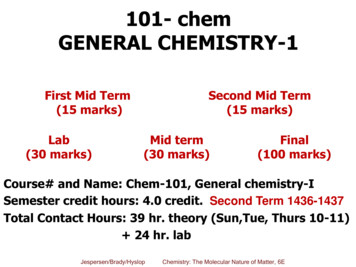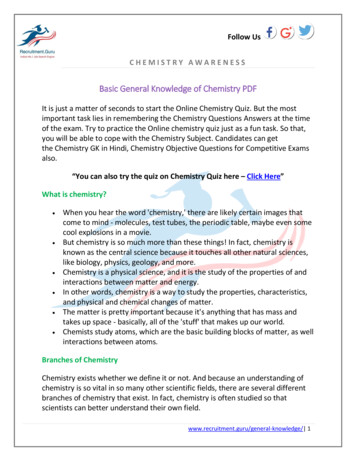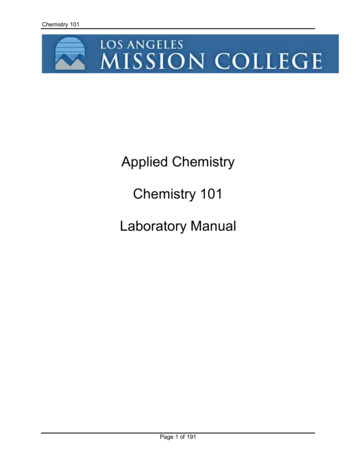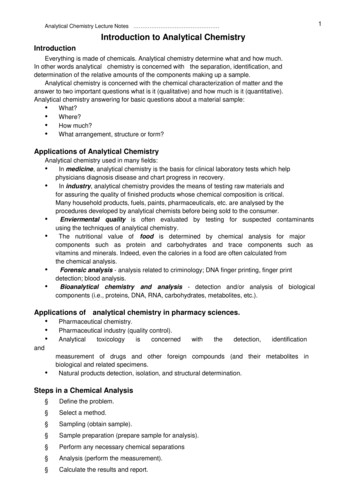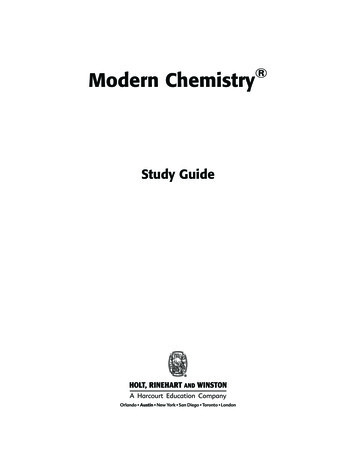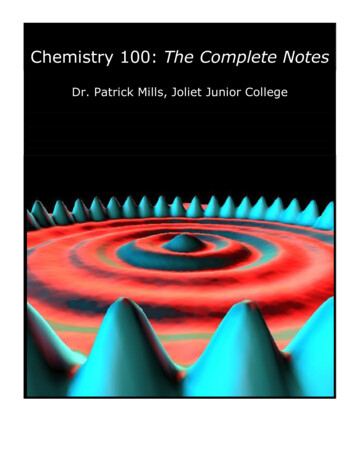
Transcription
Chemistry 100: The Complete NotesDr. Patrick Mills, Joliet Junior College
Notes
ContentsNotesPageWhy and What is Chemistry?Scientific NotationUnits and Sig. FigsDimensional AnalysisTemperature and DensityMatterEnergyChemical Foundations 1Chemical Foundations 2Chemical Reactions 12132025324558647489NotesChemical Reactions 2Chemical CompositionGasesModern Atomic Theory 1Modern Atomic Theory 2Chemical BondingIntermolecular ForcesLoose Ends and Final ReviewBlank Practice ExamsCopy of Periodic TablePage98118141149167180189199209Back coverSee the Course Website (http://ww3.jjc.edu/staff/pmills) for specific test dates and other importantinformationLegendYou will often find specific icons embedded within the notes. These respectivesymbols alert the student to the following:Represents a key fact or other piece of information, such as thedefinitions of an element and a compound.Represents a useful trick the student will likely find useful, suchas an 'EZ' way to convert between grams and moles for asubstanceAlerts the student to an important relationship between microand macro scale properties or phenomena with respect to thematerial under discussion*Such material provides a link to interesting (briefly discussed)supplemental material, often beyond the scope of the coursesyllabusDisclaimer: This document may only be downloaded, without charge, by students enrolled in Dr. Mills‟CHM 100 course(s) at Joliet Junior College. This document MAY NOT be resold, or in any other wayutilized for profit, by any third party interest.Cover Art: The „Quantum Coral‟ STM image1
Why Chemistry?“What‟s my motivation?”Why are you sitting in this class? In other words, why chemistry?Task: Write down as many reasons as you can that explain why you aretaking this class:(We will also justify responses relating to 3rd party requirements during the session)Professional programs that benefit directly from a background in chemistry1. Nursing and allied health (pre-pharm., pre-med., pre-dentistry)Example: Chlorothiazide (Diuril) is ordered b.i.d. for a infant weighing 6.5 kg. It issupplied in elixir form 100 mg/tsp. The recommended dosage for Diuril is 25 mg/kg/day.How many cc‟s should the nurse give to the child for each dose?A.B.C.D.6.15 cc.8.13 cc.4.06 cc.0.81 cc.2
2. Engineering (mechanical, civil, chemical, electrical)Example: Your company decides to import child safety seats manufactured in Asia.Unfortunately, the safety guidelines for the seats are quoted in „metric‟ units. The labelreads: “Do not exceed a 150 N load” and you must use this information to determine themaximum weight a child must not exceed in order to be protected during a collision at 55mph. Can you do it? A child‟s life, not to mention the financial future of your employer,may depend on your ability to solve questions such as this.3. Everyday / Real life situationsExample: It is time to re-carpet your 12 ft x 24 ft. family room. You visit a few carpetstores and select a brand that costs 20.50 per square meter. The sales person quotes youa total price of 749 – is this price fair, or have you just been taken advantage of?** We will return to and solve each of these three problems at some point during the courseDiscussion:What do all three of the above examples have in common?Which professions (or professionals) utilize such skills most commonly?Hint, “I pretend to beone on occasion”3
The “Cognitive Elite”Discussion: What do you think the phrase “cognitive elite” actually means?Data from „The Emergence of a Cognitive Elite‟ (Chapters 1 and 2 of TheBell Curve).People with IQ‟s of 120 (the top 10%) preferentially enter the 10 orso „High IQ professions‟ discussed above.Developing good cognitive skills is essential to entering and beingsuccessful within the „High IQ‟ and related professions. We are thefirst link in the chainExample: „Medical chain‟Increased Problem Solving AbilityTake home message: People with good cognitive / problem solving skillspreferentially find employment within fields of their choosing that arefinancially rewarding and/or intellectually satisfying.A question of some importance: How can one‟s cognitive skills beimproved?Answer(s):4
The Role of Chemistry as a Prerequisite CourseKey facts and results:Fact: The problem solving skills routinely utilized in the „high IQ‟ andrelated professions (such as nursing, business management, accounting,etc.) are introduced, learnt and mastered during physical sciencecourses.Result: Professional programs and subsequent employers insist that theircandidates have a background in one of the physical sciences – both forspecific (allied health, engineering) and general (your family room carpet)reasons.Fact: Study within any of the „high IQ fields‟ will increase cognitiveskills, but only the physical sciences do so via the study of fundamental,everyday phenomena so are of broad relevance and interest (we allinteract with and benefit from the manipulation of matter on a daily basisafter all).Result: Chemistry (and physics) may be considered to be the „gatekeepers‟of cognitive learning – chemistry in particular introduces, develops andsubsequently equips students with cognitive skills necessary to succeedin their chosen careersTake home message: While the direct relevance of chemistry to your chosencourse of study may at times seem tenuous, remember that the cognitiveskills developed during such programs of study are of significant importanceto your professional development and employability. In essence, this is whyyou are here.5
How Chemistry is Perceived & Skills Needed to Succeed inChemistryHow Chemistry is Perceived:Discussion: How did your friends and family respond when you told themyou were taking a chemistry course this semester?[“Frank” slide]Study Skills Needed to Succeed in Chemistry:Fact: As discussed above, chemistry is all about the student developingand learning to apply problem solving skills - your study habits shouldreflect this. Do NOT fall in to the trap of believing you can learn chemistrysimply by memorizing the information from your text – you must practiceapplying this information, not just be familiar with it.Result: Successful chemistry students typically spend most of theirindependent study time working assigned problems, not just reading aboutthem. To learn chemistry you must do chemistry is a truism worthremembering. An analogy would be this: you read all the books out there onthe subject of golf, but don‟t get round to swinging a club – what do youthink happens when you tee off for the first time?Fact: Chemistry relies on a cumulative method of learning, i.e. theorieslearnt from week 1 onwards will be repeatedly applied all the way throughthe course. Thus, it is important that the student does not let any „gaps‟in their knowledge develop. This fact exemplifies the differences inphilosophy between the sciences and arts, as art courses are often moremodular in nature. Example: I overhead a student tell another: “Yeah, I blewoff reading the first book in my English class, but read the second one andgot a „B‟”. This method of study is not recommended in chemistry!Analogy: Building a tower6
Result: Successful chemistry students typically have exemplaryattendance records. In some cases they may not be the „best‟ students, butguarantee themselves a better grade than more capable students, who in turntypically may miss as few as one or two lecture sessions (this is especiallytrue with regard to 3 hr. class sessions).Pictorial analogy of attendance vs cumulative knowledge„I missed a lab‟„I missed a lecture‟„I missed a couple of lectures‟Don‟t „Swiss cheese‟ or „torpedo‟ your chances of passing the coursebecause of missed work!Take home message: Simply by attending class regularly and completingthe HWK assignments you essentially guarantee yourself a passinggrade for the course, while, due to the nature of the material, deviatingfrom this approach may ensure the opposite7
What is chemistry? What do Chemists do?Reading: Ch 1. (all)Homework:1.2 questions 5, 61.5 questions 14, 16** „important‟ homework questionTask: In your own words describe what you consider chemistry to be, plusmake a list of what you think the job of a chemist is:What is chemistry?“Official” definition of what chemistry is:8
Key words:Matter: “Stuff” – anything with mass and volume. Can you think ofanything without mass or volume?The States of Matter – what are they? Are there any more?What are the basic building blocks of all matter, be it a diamond, a tree orthe air around us?„High Tech‟ science (STM or AFM, top left) is often based on simple ideas(gramophone, top right). Click logo for „flyby‟.9
All Matter is made from Atoms – the chemical formula ofthe matter tells you the number and type(s) of the atoms„inside‟.„Jeopardy‟ Example:Answer: „H2O is the chemical formula of this commonform of matter‟Question:ExamplesChemical FormulaImportantAtoms and molecules are MICROSCOPIC particles(they are very, very small), you cannot see them withyour eye!A drop of water is a MACROSCOPIC particle (because you can see it,hold it in your hand etc.) – it contains many, many, many individualmolecules of water!10
What do chemists do?“Official” definition of what chemists do:11
Chemistry in action: Explaining what happens on yourBBQ grill.The burning of a charcoal brick on your backyard grill(MACRO) explained in terms of a balanced chemicalequation (MICRO)ANY large (MACRO) scale chemical process can bedescribed using a MICRO scale chemical equationfeaturing individual atoms and/or moleculesCartoon representation of the reaction of the pertinent atoms and moleculesThe Chemists‟ description – a balanced chemical equation. This process isrepeated many billions of times (MICRO) for the burning of a charcoalbriquette (MACRO)12
Using Large and Small Numbers – Scientific NotationReading: Ch. 2 sections 1 - 2Homework:2.1, questions 2, 6, 8,10*,14** „important‟ homework questionLarge NumbersFact: Chemical problem solving most often involves using either very largeor very small numbers (e.g. counting the number of molecules in a drop ofwater, or quoting the mass of the water drop in kilograms)Recall: How many individual H2O (l) molecules are therein a drop of water. Write this amount as a regular number:Number H2O (l) molecules in 1 drop water Problem: How do we represent and manipulate such numbers in an „easier‟way?Answer:Overview Example: Consider the statement “eight million people live inLondon”. How can this quantity be best expressed numerically?„Everyday‟:13
„Better‟:Just move the decimal point to the left until you get asingle digit with decimals. The power of ten is the numberof places the decimal point moved. Example:3000 3 x 10(number decimal places to left moved) 3 x 103Examples: Write the following quantities using regular numbers and powersof 10 (scientific notation). Try to do this without a calculator at first, then seethe below tip for how to do this with your calculator‟s SCI buttonQuantity„Regular‟ quantity„Power of ten‟quantity (SCI)One hundred milesOne thousand studentsFive million peopleTwenty million dollarsFive and a half billion people14
TIP: Scientific notation (SCI) is different than the powers of 10 used inengineering (ENG). When converting to SCI powers of 10 from a „real‟number press the SCI button on your calculator, or put it in SCI mode andpress the key.Example: Enter the number twelve million (12000000) into your calculator.Press the SCI key, and then repeat with the ENG key. What numbers do youget?SCI:ENG:Wrap up: quote the number of H2O molecules in 1 drop water using SCInotation:1,000,000,000,000,000,000,000 molecules moleculesREMEMBER: In chemistry we ALWAYS use scientific notation (SCI)for expressing large ( 100) or small ( 0.1) numbers.Small NumbersQuestion: How can very small numbers be expressed in SCI notation?Just move the decimal point to the right until you get asingle digit with decimals. The negative power of ten is thenumber of places the decimal point moved. Example:0.00125 1.25 x 10- (number decimal places to right moved) 15
Examples: Convert the following regular numbered quantities to powers of10 (scientific notation). Try to do this without a calculator at first, then checkwith your calculator.„Regular‟ number(quantity)„Power of ten‟ number (SCI)(quantity)0.00015 grams0.125 %0.0458 mLReview: You now know how to convert large or small „regular‟ numbersinto SCI notation either on paper or using your calculator.Entering and Manipulating Large and Small Numbers: (using the EEor EXP button)Enter the following SCI notation numbers into your calculator - try to useEE or EXP key, then press the (in „FLO‟ mode) to obtain the „real‟number equivalent:„Power of ten‟ number (SCI)Regular number5 x 10-11.5 x 1033.56 10-3Did you get the answers right? PLEASE LET ME KNOW IF YOU NEEDASSISTACE WITH THIS EXERCISE16
Task: Use your calculator to solve the following math problem – use the EEor EXP to enter the numbers in SCI notation. What happens if you try thesame math using other keys, such as 10x or ?3 x 1076 x 103 What answer did you get? What problems were encountered?Using only the EE or EXP keys to express powers of 10 values, calculatethe following. PLEASE LET ME KNOW IF YOU NEED ASSISTACEWITH THIS EXERCISE:1. (4 x 10-9)(2 x 104) 2.4 x 10-93 x 104 3. See class examples17
Making things even simpler – S.I. PrefixesCertain powers of 10 can be replaced by a symbolknown as a decimal (or S.I.) prefixUse the slide shown or data from your book to complete the following table:PrefixSymbolMeaningGigaG1000000000 (billion)MegaM1000000 (million)k1000 (thousand)DeciPower of 101 x 1060.1 (tenth)cMilli1 x 10-6NanonFor decimal (S.I.) prefixes, just swap the appropriate “x10n” part of the number for the equivalent prefix‟ssymbol. Example:1.25 x 10-3 g 1.25 mg (milligrams)18
Task: Convert the following quantities to SCI notation and decimal prefixnotation:QuantityWith SCI notationWith Decimal Prefix0.0000020 meters0.0015 grams3,000 dollars12 million peopleTask: Now convert the following quantities to SCI notation and „regular‟numbers:QuantityWith SCInotationAs a „real‟ number (quantity)2.5 mm5.2 km50 MW12m (microns)Discussion: Make a list of as many „everyday‟ quantities as possible that usedecimal prefixes (or similar related expressions):19
Units and Significant figuresReading: Ch. 2 sections 3 - 5Homework:2.2, questions 15,16, 18,2.5, questions 38, 39, 42*, 44** „important‟ homework questionCommon UnitsDiscussion: List some common units of measurement we use on a dailybasis. How did these units originate?Familiar UnitQuantity measuredMassQuestion: What are the „metric‟ (S.I.) versions of the everyday units listedabove?Quantity measuredFundamental S.I.Unit (base unit)SymbolNotes: SI base units are used to determine derived S.I. units, as discussedbelow. Some S.I. base units feature a decimal prefix – which one(s)?20
Discussion: Why do scientists prefer the S.I. system?Derived S.I. UnitsInsert appropriate S.I. base units into an equation thatdefines the respective derived S.I. unit. Example:Area length x length m x m m2the derived S.I. unit for area is m2Determine derived S.I. units for the following quantitiesQuantity measuredMath involving S.I. base unitsDerived S.I. unitVolumeVelocity (speed)DensityForce*Energy**These are harder examples. To solve them start by inserting appropriate S.I.base units into an equation that defines the quantity sought.21
Questions:Is the S.I. unit of volume (m3) reasonable for everyday applications? Why?What unit of volume do chemists prefer? Why?More detail on the chemist‟s volume unit22
Significant Figures and Rounding OffQuestion: What are significant figures?Task: Measure the length of your pencil (or some other object) in cm using astandard ruler. To how many sig. figs can you determine this value?ObjectSize of measures (cm)Number sig. figs.Let‟s figure out the rules for sig. figs. What is:1.002 to3 sig. figs.1 sig. fig.569.74 to3 sig. figs.4 sig. figs.1 sig. fig.0.00017 to1 sig. fig.23
Zeros before the first number are NOT counted assignificantZeros after the first number ARE counted as significantRound UP if the number after the last significant digit is 5Quote numbers in SCI notation if number sig. figs. digits before decimal point.Multiplication and division (99% of your work is either one and/or theother)The result of any multiplication or division has the samenumber of sig. figs. as the measurement with the lowestnumber of sig. figs. Example: A sample of lead has a massof 2.105 g and a volume of 0.11 mL. What is the density oflead?Answer:Another example: What is the area (in ft2) of a 12.5 ft x 24 ft room?What common mistake was made in the determination of length here?24
Dimensional Analysis (Conversion Factors)Reading: Ch. 2 sections 6Homework:2.6, questions 60, 64*, 68, 70* „important‟ homework questionBackgroundWe do simple conversions between different units on a daily basis. Forexample:Question:How many eggs are there in 1 dozen eggs?A statement such as this can be written as an identity1 dozen eggs 12 eggsRecall: Is the above identity a measured or exact relationship? How wouldits use affect the number of significant figures used in any answer?Using Identities and Conversion FactorsOverview Example: How many eggs are there in 42 dozen eggs?Use the appropriate identity to create a conversion factor.The conversion factor will transform the quantity into thedesired form.Math:42 dozen eggsx 25
Conversion factors are simply identities written asfractions. Each conversion factor has two „versions‟Task: Complete the following table by transforming the stated identity intoits two corresponding conversion factors. Also include at least threeadditional conversion factors that you have encountered.IdentityConversion factorsExact?(Y/N)1 in 2.54 cm1 kg 2.205 lb1 m 100 cm1 ft 12 inches26
Discussion:How do you know which version of the conversion factor to use? Why?For none exact identities and conversion factors, how many sig. figs areimplied?Example: Use the information from above to determine how many cm thereare in 12.00 inches.12.00 inchesx The unit belonging to the quantity and the denominatorof the conversion factor cancel to leave a final answerwith the desired unitGeneric Form:27
Task: Complete the following conversions. See your text for appropriateconversion identities.5.51 cm to meters23.0 ounces to pounds50.0 nm to meters6.56 miles to km45.7 inches to cm220 pounds to kg(you choose examples)28
Conversion Factor „Chains‟Question: How do you approach a problem like “Convert 55 cm into feet” –where there is no available single conversion factor?Answer:55 cm xx Link as many conversion factors as necessary together inorder to crate a „chain‟. Each „link‟ in the chain convertsone unit to another and so on until the answer is reachedTask: Complete the following „chain‟ conversions. See your text forappropriate conversion identities.1.68 m to inches5.8 km to feet4.00 ounces to grams29
Question of the week: Remember that nursing question from week 1? Let‟stry it now .Example: Chlorothiazide (Diuril) is ordered b.i.d. for a infant weighing 6.5 kg. It issupplied in elixir form 100 mg/tsp. The recommended dosage for Diuril is 25 mg/kg/day.How many cc‟s should the nurse give to the child for each dose?A.B.C.D.6.15 cc.8.13 cc.4.06 cc.0.81 cc.„Medical‟ conversion factorsb.i.d.: 2 dose 1 day1 tsp. 5.0 mL30
“Conversions”The following questions were taken from your 1st practicemidterm:Complete the following conversions (include correct number of sig. figs.):95.5 pounds to kgANS: 43.3 kg (3 sf)1032 cm to metersANS: 10.32 m (4 sf)12.5 miles to kmANS: 20.0 km (3 sf)o-156 C to Kelvin(see next handout)ANS: 117 K1300 Cal to kJANS: 5439 kJ or 5.439 x 106 J (4 sf)31
Temperature and DensityReading: Ch. 2 sections 7 - 8 Homework:2.7, questions 72, 74, 76, 78*, 82*2.8, questions 86, 90, 92*, 94*, 96, 100** „important‟ homework questionTemperatureBackground: There are three temperature scales in common use today. Canyou name them?How were the end points of the two „metric‟ scales defined? In other words,what natural conditions define these respective temperature values?The Centigrade and KelvinScalesThe Centigrade scale compared to thestate of H2O32
Converting between Degrees Celsius and KelvinTask: By looking at the above graph, describe how the oC and K scales arerelated. What do they have in common? What is different?1.2.Simply add 273.15 to ANY temp. quoted in oC to obtainthe equivalent K valueORSimply subtract 273.15 from ANY temp. quoted in K toobtain the equivalent oC valueExamples:1. What is 50oC in Kelvin?2. What is 200 K in Celsius?33
Comparing the Fahrenheit, Kelvin and Celsius Temperature ScalesDiscussion: We saw that the end points for the oC scale corresponded tospecific „natural‟ temperatures – the same is true for the oF scale. What„natural‟ temperatures do you think 0 oF and 100 oF correspond to innature. How about 212 oF and 32 oF?“You want to putwhat,where?!.”Diagram: Fahrenheit, Celsius and Kelvin thermometers side by side.Question: What is the obvious error in the above diagram?34
Task: By looking at the previous diagram, or the slide provided, describehow the oC and oF scales are related. What do they have in common? Whatis different?The two basic differences between the oC and oF scalesallow for equations relating them (conversion equations)to be constructed:For converting oC to oF:For converting oF to oC:Question: What is 90 oF in oC and in Kelvin?Ask me about the extra credit temperature .35
Temperature RangesDiscussion: If something is boiling, is it necessarily „hot‟?If it is frozen, is it necessarily „cold‟?Task: View and make brief notes on the „temperature scale‟ slide. Think ofthe „hottest‟ and „coldest‟ things you come into contact with on a daily basis– where do they fit into the „bigger picture‟?36
DensityNOTE: THE FOLLOWING IS A REVIEW OF THE MATERIAL YOUWILL LEARN DURING LAB #2.Review: How was the property of density defined during a previous lecture?Density:Where: „amount of matter‟ Discussion: What is the S.I. unit of density? Is this a convenient unit?Density Question: What are the two „convenient‟ derived S.I. units of density usedby chemists?37
Density MathRecall: Density is defined by a simple equation, which hasthree related forms:1.2.3.If you have problems with cross multiplication,remember that „pyramids‟ can also be used to solvedensity and other 3 variable equations:Example: 23.5 mL of a certain liquid weighs 35.062 g. What is the densityof the liquid? What mass will 20mL of this liquid have?38
Density ApplicationsFinding the Volume and / or Density of Solid ObjectsNOTE: THE FOLLOWING IS A REVIEW OF THE MATERIAL YOUWILL LEARN / HAVE LEARNT DURING LAB #2.Irregular shaped objectsAny Object will DISPLACE it‟s own volume of waterwhen submergedRecall lab: Sketch the apparatus you used to measure the volume of therubber stopper:1. Before the stopper was added2. After the stopper was addedExample: A solid object weighing 15.250 g is submerged in water, duringwhich time the water level rose from 50.0 mL to 60.2 mL. What is thedensity of the object?39
Regular shaped objectsRegularly shaped objects (cubes, „bricks‟, spheres,cylinders, cones .) have equations that define theirvolume.Task: Sketch the following 3-D shapes and list the equations that define their volume (seeyour text book)Sketch of 3-D ShapeVolume equationCubeV „Brick‟V SphereV Cylinder or diskV 1. Find the volume of the object in question via theequation that defines its volume (be sure to use cm for alllength dimensions).2. Substitute the derived volume value in D M/V to findthe object‟s density (recall that mass is measured ingrams).Recall: the radius of a circle equals half of it‟s diameter (i.e. dia. 2r)40
Example: Dice used in Las Vegas weigh 2.65 g and havesides of length 1.2 cm. What is the density of a Las Vegasdice?Densities of common materialsMaterialState (s), (l) or (g)Density Silver10.5Lead11.34MercuryGold13.619.3241
“Will it Float?”The David Letterman Show on CBS often features a segmentcalled „Will it Float‟. Simply, Dave and Paul try to determineif an object, such as a refrigerator or 100 ft of insulationcable, will float when dropped into a large container ofwater.Question: What physical property of a material will determine „if it willfloat‟? What would be a more scientifically accurate (if less catchy) namefor the „Will it float‟ segment on Dave‟s show?Discussion: “Battleships and datingadvice”Task: Using the table supplied above, sketch a picture of what would happenif 30 mL samples of ethanol, mercury and water, as well a silver dollar anda gold ring were added to a volumetric cylinder.42
Question of the week (group work)If a 200 mg piece of gold is hammered into a sheet measuring 2.4 ft by 1.0ft, then what is the sheet‟s thickness in meters? If a gold atom is 0.26 nmwide, how many atoms thick is the sheet?43
“The Wire” & “Sketch”The following questions were taken from your 1st practicemidterm:A copper (Cu) wire has a mass of 4.00 pounds and a diameter of 5.00 mm. Determinethe wire‟s mass and in the units specified below. Include any appropriate decimalprefixes in your final answers. Density of copper 8.95 g/cm3Mass of the wire in kg:ANS: 1.81 kg (3 sf)Volume of the wire in cm3:ANS: 202 mL (3 sf)Sketch a fully labeled diagram illustrating the appearance of a 100 mL cylinder after thefollowing items have been added to it:Material40 mL D.I. waterA medium sized silver ring40 mL liquid mercuryA small gold coin20 mL Olive oilDensity (g/cm3)1.00010.5013.619.320.756ANS:TopBottomOlive OilD.I. WaterSilver ringMercury (l)Gold coin44
MatterReading: Ch 3 sections 1 - 5Homework:3.1, questions 2, 4, 6, 8*3.2, questions 12, 16, 18*3.3, questions 20, 243.4, questions 26, 28, 30*, 32*3.5, questions 34, 36* „important‟ homework questionReview: What is the („MTV‟) definition of matter?Recall: “Chemistry is the study of matter and its properties, the changesmatter undergoes and the energy associated with those changes”Recap: There are 3 stable states of matter – solid (s), liquid (l) and gas (g).Specific physical properties define the 3 states of matterState of Matter Macroscopic Description(observation)Microscopic Description(chemical model)SolidLiquidGas45
The state matter is in depends on the strength of theforces (chemical bonds) between the individualmicroscopic particles within the matterTask: Rank the intermolecular forces present in steam, ice and water inorder of increasing strength. Use the slide or above figure as a guide.Changing between the 3 states of matter (a physical property)Question: How do you convert H2O (s) (ice)back again?H2O (l) (water) andNotesQuestion: What happens on the microscopic level during the aboveprocesses (recall previous slide)? How is this related to boiling and freezingpoints?46
Physical and Chemical Properties – what‟s the difference?Analogy: We all posses „as is‟ properties, or characteristics,that define us. For example, Dr. Mills is 5‟11” and has greeneyes.Physical Properties As with people, each chemical also possesses a unique setof „as is‟ (physical) properties that define it. For example, water is a clear,colorless, tasteless molecular material that has a fpt. of 0 oC and a bpt. of 100oC.Chemical Properties, in contrast, are a function of change (usuallyassociated with a chemical reaction). For example, Iron (Fe) reacts withoxygen gas to form rust:4 Fe (s) 3 O2(g) 2 Fe2O3 (s)Task: Identify the flowing as either chemical or physical propertiesPropertiesChemical or PhysicalDiamond is the hardest knownsubstance.Charcoal burns to make CO2 (g)The statue of liberty turned „green‟Copper is a good conductor ofelectricitySugar dissolves in water*Think up two more chemical properties of your own - 6 more physical properties tobeat the record(!)47
Elements and CompoundsTask: State which of the following are elements, and which are compounds.When done, try to come up with a definition of what elements andcompounds are.MaterialChemical FormulaWaterH2O (l)Oxygen gasO2 (g)Pure silver coinAg (s)Sugar crystalsC6H12O6 (s)Carbon dioxide gasCO2 (g)Element orCompound?Elements:Compounds:48
Note: Compounds and elements can have either „giant‟ or molecularstructures:„Giant‟: Repeating lattice of particles – usuallystrongly bound (high mpt.) solids.Examples: sand (SiO2), diamond (C), table salt(NaCl)Molecular: a collection of independent molecularunits (molecules will be discussed in more detaillater). Usually (low mpt) liquids or gasses at roomtemp.Definition: Molecule – a small, independentparticle of matter made up from 2 or more atomsExamples: water (H2O), carbon dioxide (CO2),Nitrogen gas (N2)Think of molecules like cars on the expressway – each car(molecule) is a separate, independent unit that contains anumber of passengers (atoms). The cars (molecules) arefree to move while the people (atoms) stay fixed inside.„Giant‟ materials are like people (atoms) „locked‟ in placeat a very crowded concert, the DMV waiting roometc 49
A molecule is an independent unit containing two or moreatoms. Remember the car / passenger analogy from aboveTask: Classify the following molecules as either elements or compoundsHF:Br2:NH3:CCl4:CO2:N2:Wrap Up: A microscopic scale view of several materials is presented below.Label each using elemental or compound and molecular or „giant‟ tagsWater (H2O (l))Silicon (Si (s))Steam (H2O (g))Sodium Chloride (NaCl)50
Pure Materials v MixturesRecap: Pure matter is classed as either an ELEMENT or aCOMPOUND.Elements can have either Molecular or „giant‟ structures.Examples: N2 (g) (Nitrogen gas, molecular),
5 The Role of Chemistry as a Prerequisite Course Key facts and results: Fact: The problem solving skills routinely utilized in the „high IQ‟ and related professions (such as nursing, business management, accounting, etc.) ar


